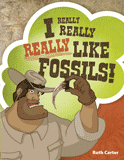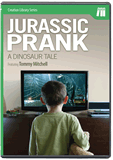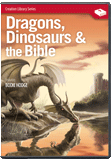
Big Dinosaurs Won the Battle but Lost the War
Big dinosaurs won the battle but lost the war, and the real winners took to the skies.
News Source
- SOURCE: “MSNBC: “Why Huge Dinosaurs Had Such Tiny Babies”
The latest evidence, according to a Swiss researcher, suggests dinosaurs did not evolve their gigantic sizes due to the richness of their environment.1 Therefore, the dinosaurs needed another reason to evolve enormity. A new evolutionary model proposed by Zurich’s Daryl Cordon suggests dinosaurs grew big to outcompete other dinosaurs. Being successful, these big dinosaurs ruled the world by the time catastrophic mass extinction struck (possibly in the form of a meteor).
“The most successful (dinosaurs) were the very large ones that were able to escape the competition trap and replenish their numbers. After the mass extinction, they again tried to evolve large size, but to escape the competition trap they had to become multi-ton animals,” says Codron.
But having won the battle for supremacy, these same big dinosaurs lost the war for long-term survival of their species. Dinosaurs laid eggs. Egg size is limited by shell thickness. “One cannot have a very large egg with a very thin shell, otherwise it would simply break open,” Codron explains. “The shell itself is limited in thickness. It cannot become so thick that gas can no longer diffuse through it, which would deprive the embryo of oxygen. For a very small egg-laying animal this is no problem, but it does mean that very large animals have to produce relatively small eggs.”
The giant dinosaurs’ eggs therefore had to remain small despite their large adult size. Small hatchlings, to reach adulthood, then had to grow through many size categories and consequently survive competition in many ecological niches. Codron’s model proposes the big dinosaurs had won the battle before the big catastrophe struck, destroying—as the popular scenario goes—all creatures above about 22 to 55 pounds.
The question that haunted some people including me is . . . why did the mammals survive and why did the dinosaurs not?
“The question that haunted some people including me is . . . why did the mammals survive and why did the dinosaurs not. I think we have a very good answer for that,” says co-author Marcus Clauss.2 Following the catastrophe, the majority of those left to replenish the earth would have been the large species. With reduced numbers, their small fry became crunchy critters for mammalian neighbors. (The fossil record does contain evidence of a juvenile dinosaur in the stomach of a large mammal, a Repenomamus.) Meanwhile, mammalian young survived on mothers’ milk. Thus, having placed all their eggs in one basket—metaphorically speaking—dinosaurs finally went extinct.
The final chapter in the story proposed by Codron explains the proliferation of birds. Many (though not all) evolutionists believe dinosaurs evolved into birds. Therefore, after the catastrophic extinction, Codron proposes some smaller dinosaurs learned to fly and “slipped the surly bonds of Earth”3 to fill the ecological niches of the air.
Codron bases his model, published in Biology Letters, on mathematical simulations of populations with a variety of body sizes. The model represents an attempt to explain the fossil record within the evolutionary worldview and thus demonstrates the influence of worldview on the way evidence is interpreted. A biblical worldview would assign a different timescale to the geologic column’s fossils—noting the majority of them to have been deposited over a matter of months and not millions of years—and would identify the catastrophe not as death striking from the sky but rather the global Flood.4
There is no reason to doubt that after the Flood animals descended from those preserved on the Ark faced competition and environmental challenges. Many weathered those challenges and replenished the earth, but some of those became extinct later just as animals go extinct today.
To suppose “the most successful dinosaurs were the very large ones” reflects an evolutionary interpretation of the fact that, in the fossil record, the dinosaurs represented in the higher rock layers are primarily the larger ones. However, the Flood model interprets much of the geologic column as a record of the order of burial during the time of the rising floodwaters. As such, larger size may have helped some to evade rising water longer, with their “success” being measured in weeks, not eons.
But to agree that environmental challenges and competition contributed to the extinction of some species after the catastrophic global Flood—just as we see in today’s world—is NOT to agree that some kinds of animals evolved into other kinds. For instance, the aerial success of birds does not require them to have evolved upward from dinosaurs but only to have flown off the Ark at the end of the Flood year.
Likewise to agree that egg size is limited by various physical and biological constraints does not prove why some dinosaurs grew so big, only why big dinosaurs had to lay small eggs. This is an interesting biological phenomenon but in no way supports the idea that dinosaurs had to evolve from anything or into anything. The population models Codron proposes are not unreasonable, but their application to evolutionary scenarios is just so much storytelling. Reliable answers in matters of historical science require an eyewitness account, and, for questions of origins of life and various kinds of animals, the only source is the Creator’s eyewitness account in the Bible.
Further Reading
- Dinosaur Killer
- New Model of Meteorite Strike Reveals Extinction Theory
- Closing In On the K-T Boundary of Dinosaur Extinction
- Did Meteors Trigger Noah’s Flood?
For More Information: Get Answers
Remember, if you see a news story that might merit some attention, let us know about it! (Note: if the story originates from the Associated Press, FOX News, MSNBC, the New York Times, or another major national media outlet, we will most likely have already heard about it.) And thanks to all of our readers who have submitted great news tips to us. If you didn’t catch all the latest News to Know, why not take a look to see what you’ve missed?
(Please note that links will take you directly to the source. Answers in Genesis is not responsible for content on the websites to which we refer. For more information, please see our Privacy Policy.)
Footnotes
- Matt Kaplan, “Dinosaurs Grew to Outpace Their Young,” Nature, April 18, 2012, http://www.nature.com/news/dinosaurs-grew-to-outpace-their-young-1.10465.
- “Shells Made Dinosaurs Egg-stinct, Scientists Say,” FOX News, April 18, 2012, http://www.foxnews.com/tech/2012/04/18/shells-made-dinosaurs-egg-stinct-scientists-say.html.
- John Gillespie Magee Jr., “High Flight,” http://www.arlingtoncemetery.net/highflig.htm.
- See “Dinosaur Killer,” “Closing In On the K-T Boundary of Dinosaur Extinction,” “News to Note, October 1, 2011,” and “New Model of Meteorite Strike Reveals Extinction Theory” for more about the reasons evolutionists hypothesize that such an event occurred. For more information about a possible link between meteors and the global Flood described in the Bible, see “Did Meteors Trigger Noah’s Flood?”
Recommended Resources

Answers in Genesis is an apologetics ministry, dedicated to helping Christians defend their faith and proclaim the good news of Jesus Christ.
- Customer Service 800.778.3390
- © 2024 Answers in Genesis





